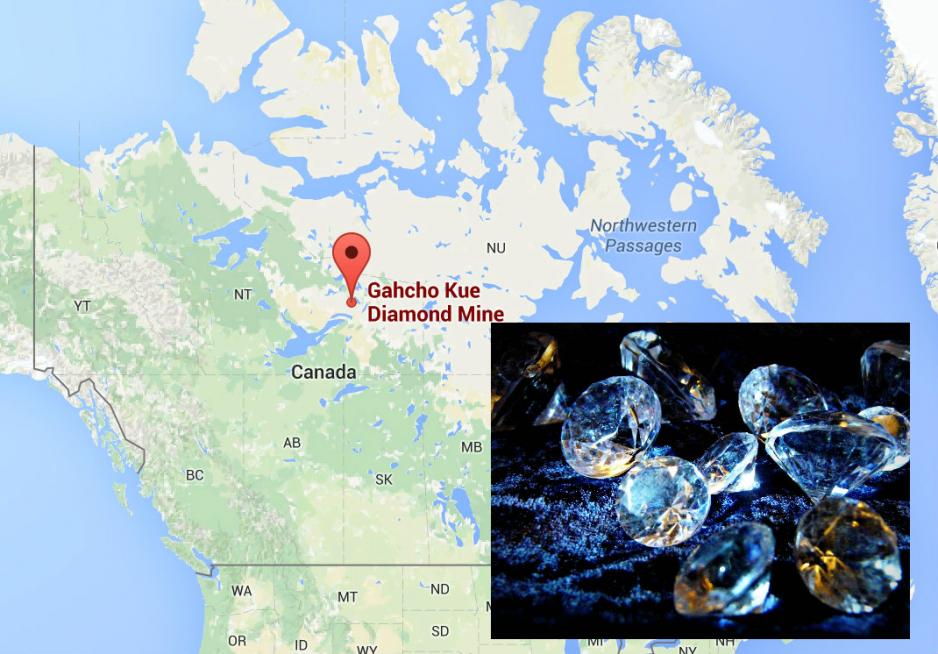Not All That Glitters is Gold

Gacho Kué is the largest new diamond mine currently in development globally. (Collage: Google Maps/Judy van der Velden)
Huge potential for Northerners to benefit from a new diamond mine in Canada´s North.
Huge potential for Northerners to benefit from a new diamond mine in Canada´s North.
Canada is currently the third largest produce of diamonds in the world, falling behind only Botswana and Russia; it produces 15% of the world’s diamonds, measured by value.
Canada’s position in this industry is only set to gain with the Gacho Kué mine, which is primed to open this year, stemming from a joint venture between De Beers and Mountain Province Diamonds. This diamond mine, found in the Northwest Territories, will be another opportunity for Canadians to pursue industry in the North and for a company to prove its willingness to help foster relationships with Indigenous Peoples.
Creating jobs
Creating jobs will be one of the key benefits, which will be fundamentally important because of the recent news that the Snap Lake diamond mine was to be closed.
Gacho Kué is the largest new diamond mine currently in development globally and therefore has the potential for creating tremendous economic benefits in a part of Canada that needs it. Although Canada is quite new to the diamond mining industry, having really started production only in the late 1900’s, the benefits have already been seen.
With the estimation of production being 4.5 million carats a year, there is huge potential for Northerners to benefit from this new mine. Parts of the North are lacking infrastructure, sources of income, and types of employment for newer and older generations. Introducing viable sources of income, while maintaining the environment and respecting the Peoples who live there will be one of the challenges that Gacho Kué will face, as do most major projects in the North. At least an attempt at sustainable development will hopefully be the name of the game, accepting that mining itself is not sustainable.
Both positive and negative effects
Although there are definite economic benefits to opening a diamond mind, there are several negative impacts that can also come about. These impacts can be mitigated to a large degree, if companies are willing.
For example, Gacho Kué will ideally strive to create and meet quotas set out for hiring Northerns, which, instead of creating an influx of temporary workers who will leave ghost towns, will enable communities in the North to flourish.
This is easier said than done in an area so sparsely populated with eligible workers, and other mines in the North, such as Ekati and Diavik, have had trouble with this. Furthermore, the area which Gacho Kué will operate is traditionally used by the Dene Nation of Lutsel K’e, which means there are substantial concerns about the environmental impacts that this mine will have. These were set out in a presentation which allows for traditional knowledge to play a role in making decisions in the North.
Hopefully De Beers and companies working in the North will listen to the knowledge of Peoples who have long prospered in the area.
Involving First Nations
Tom Ormsby, De Beers Canada’s director of external and corporate affairs has said that the involvement of the First Nations is essential when working in the North. And with De Beers looking towards expanding their mining in Canada, this mindset is fundamentally important to the Peoples living there.
But is it enough? Many living in First Nations and Inuit communities are still skeptical of the benefits these mines can bring, a documentary called After the Last River, analyzes the impacts of a De Beers mine in Ontario and the impacts to the Attawapiskat community that live nearby.
Only 12 years
The potential for economic growth in the Canadian diamond mining industry is significant. Not only are there companies looking North, but some are focusing on other provinces, such as Saskatchewan.
Canada once again finds itself in a position where it has the potential to benefit from another natural resource that it has been blessed with, but hopefully those providing leadership in this industry will recognize the importance of creating long term benefits, and not just short term gains.
Diamond mines have very distinct end dates, Gacho Kué for example will be operational for only 12 years, but there is an opportunity to work together with communities to further the benefits that this input of revenue can have, instead of leaving desolate wastelands where flora and fauna have been irreparably decimated.
